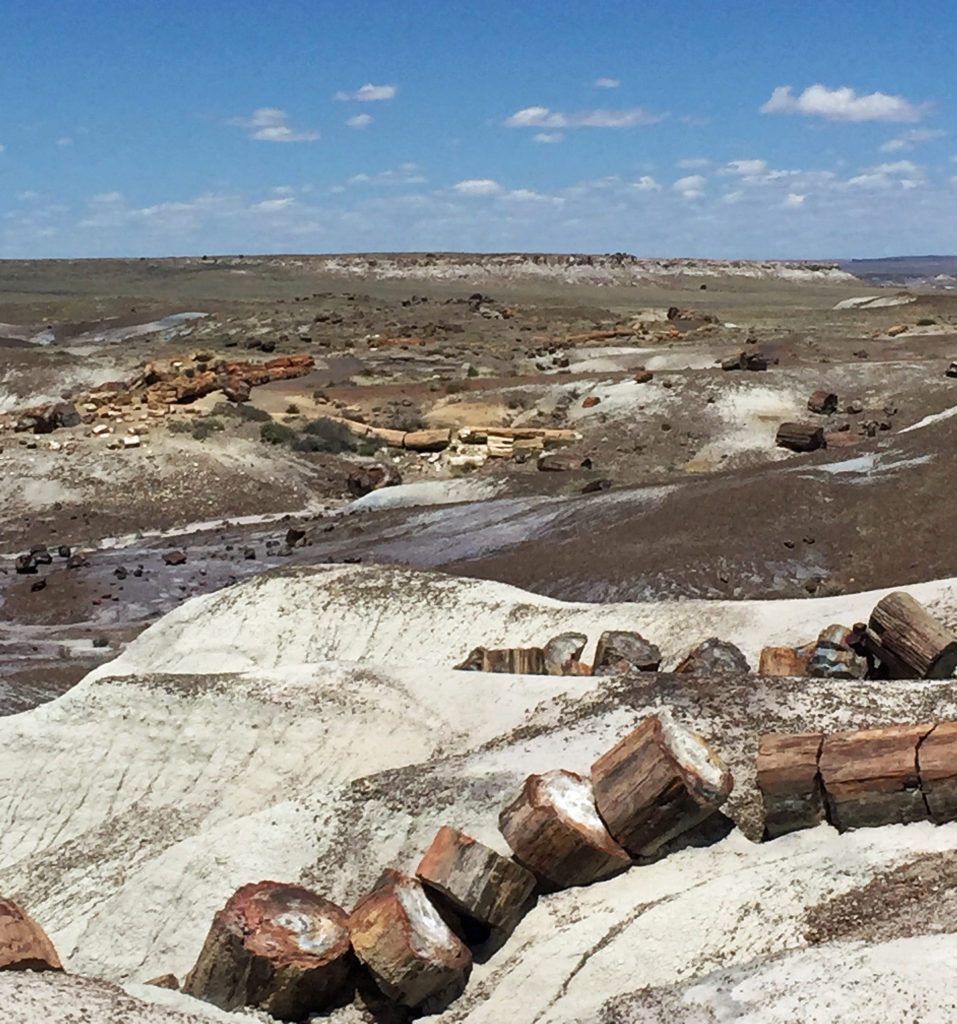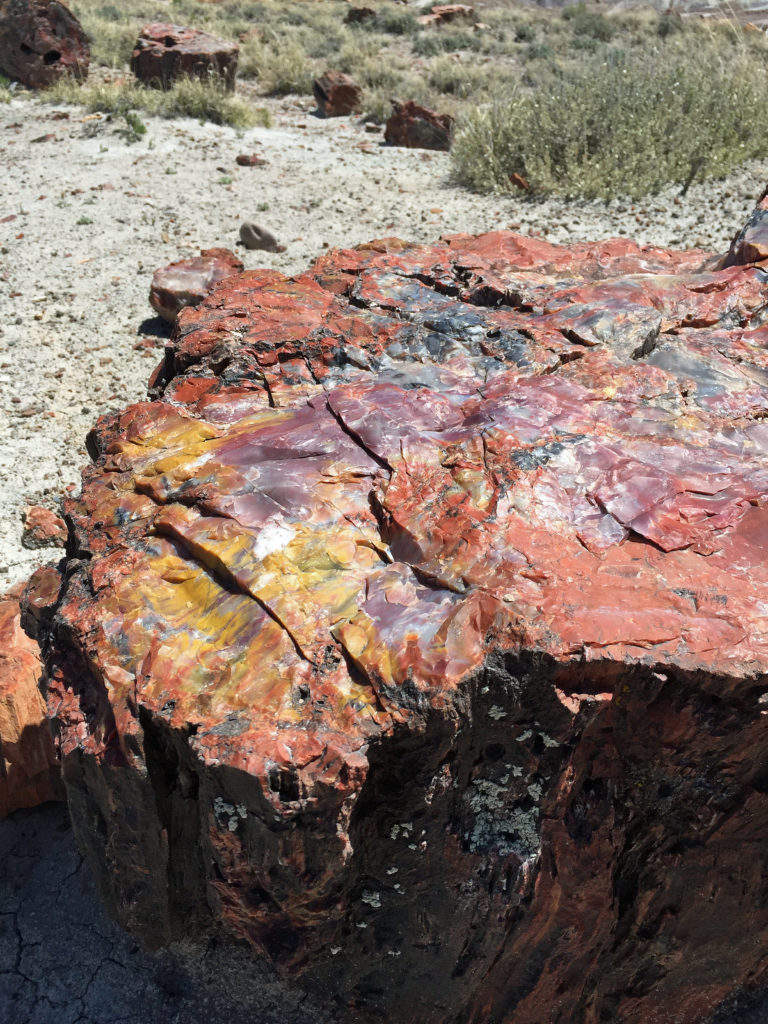
Dear reader, last featured was a post about the Painted Desert which is situated north of interstate 40, just outside Holbrook, Arizona. As you drive through the national park, you will cross over 40 but you will also pass what was originally part of Route 66 or the Mother Road. Here sits a wonderful old, rusty and sweaty Studebaker to mark what once was a part of the passage from the Midwest to the West. It is here that begins the Petrified Forest.
This summer, two of our lovely grandchildren visited with us and we enjoyed taking them to see some of the wonderful things that nature has to offer. But we did giggle when one granddaughter was downcast at the fact that the forest wasn’t actually standing. An honest mistake, to be sure. However, once she understood the mechanism of nature’s forces and the end product of those functions, she thought it was about the kewlest thing she had ever seen. Lovely when reality and learning come together to create fun AND an AH HA! moment all at the same time.
Before we get to the forest, there is a stop on the way where you can look down into a wash filled with rocks….no, giant boulders. Those boulders are covered with petroglyphs of all kinds. I will tell you two things about the photos that follow. First, I took these on a slightly cloudy day and they were quite prominent. When I returned on another occasion, it was too sunny. Everything was washed out and barely visible. However, I still manipulated the photos below to enhance the appearance of the glyphs.

The most eye-catching is the perpetual circle but if you look closely, there are hundreds of petroglyphs.

The is a continuation of the rock above, just wrapping around the rock face. Keep in mind that they didn’t just scratch one rock across the other to make these images. Each one is not unlike pointillism painting….they chipped and hammered away points of rock face to create each and every one of these images. Note the large lizard in the middle, antelope to the left and hand print to the far right. There is a “Hang Ten” foot at the corner of the boulder too.

Again we see a spiral or endless circle, several large images of people and animals.

A bit more detail of the left side of this rock outcropping and the art work that has been bestowed upon it.

One last look at the first large boulder or outcropping that is simply awash with art.

For a bit of perspective, the train is running parallel to interstate 40, the Painted Desert stretches to the north and the rocks in the foreground surround the wash where the petroglyphs are found. This is a vast and wide open area.
Now on to the forest!
This section will be light on information and heavy on photos. The trees convey far more information that I could ever begin to try to. However, a bit of history will help put what you are looking at into perspective. While the land that you are viewing above isn’t lush, green or forested; it would have been all of those things during the Triassic Period. During that time period, this swath of land was about 10 degrees north of the equator or about equal to Costa Rica’s current position on the planet. The continent of Pangea broke apart and the North American continent went, well….north. Fast forward about 218 million years and this area known as the Crystal Forest is resting at about 35 degrees north. The area of the Colorado Plateau moved north and then lifted slowly upwards about a mile higher than sea level. Now the park is arid but it is also a time capsule of how things were during the Triassic Period.

As you can see, the multi-colored layers of sediment begin to meld with the many broken pieces of the forest. But let’s see a few more photos and I will explain how this all happened.

While it looks like someone cut these logs or broke them into pieces, they are no longer wood but crystalline quartz. The breaks are a result of continual settling and erosion. The area of the Petrified Forest was on the edge of a river channel some 218 million years ago. Trees fell due to disease, age or storms and they submerged into the river and the floodplain. With time, periodic flooding buried a portion of these trees underneath many layers of silt. As the trees were encased with silt and silica rich groundwater percolated through the logs, the wood was replaced with a quartz replica of the wood tree.

See that log protruding from the cliff face? While many layers of silt and sediment were laid down, the cycle of erosion never ceases and that is why the logs have “reappeared”.

A closer look. Due to the weight of the quartz, the shifting of the underlying and overlying soil creates cracks. Following the path of least resistance, the cracks grow perpendicular to the length of the log thereby giving the appearance that someone sliced these trees into pieces.

The process of petrification depends on the rate of silting, measure of silica in groundwater and other environmental conditions. The initial stages may take only decades (the silica must penetrate the wood before it has a chance to rot), but it takes millions of years to change that silica into the beautiful quartz that we see here. By the time T. Rex roamed this area, these trees had been petrified for nearly 135 million years.

There is NO wood here, it is all petrified into quartz. The areas that are white are pure quartz but contaminants in the groundwater helped to create this masterpiece. Iron oxides lend red, yellow, orange and purple while manganese oxides create black and grey tones.

Look at the amount of iron oxides that penetrated this particular log. Each one is like a work of art.

Many of the logs are massive and they seem to be every where you look

Amazing! The one on the crest makes the one in the foreground look tiny.

The mesas of the painted desert loom in the background

Piles of logs scattered about with all their detail and brilliant colors

Petrification “froze” the look of the logs. Many of the logs have visible knots and what appears to be bark present on the exterior.

The detail is simply incredible

Nature is a mysterious and powerful thing. There are tales of those who have taken home a souvenir piece of the forest, only to find that the “curse” of the forest has befallen them. Each year, the park service receives about a pickup truck load of packages….all containing returned pieces of the Rainbow Forest and most containing a note. These letters written on everything from notebook paper to cocktail napkins, arrive from around the world. They all exclaim that bad luck has rained down upon them and they want these pieces of the forest returned. This is what the park calls the conscience pile.
Just don’t steal.
In case you think that there is nothing else of note in the Painted Desert and Petrified Forest, meet my little friend.

